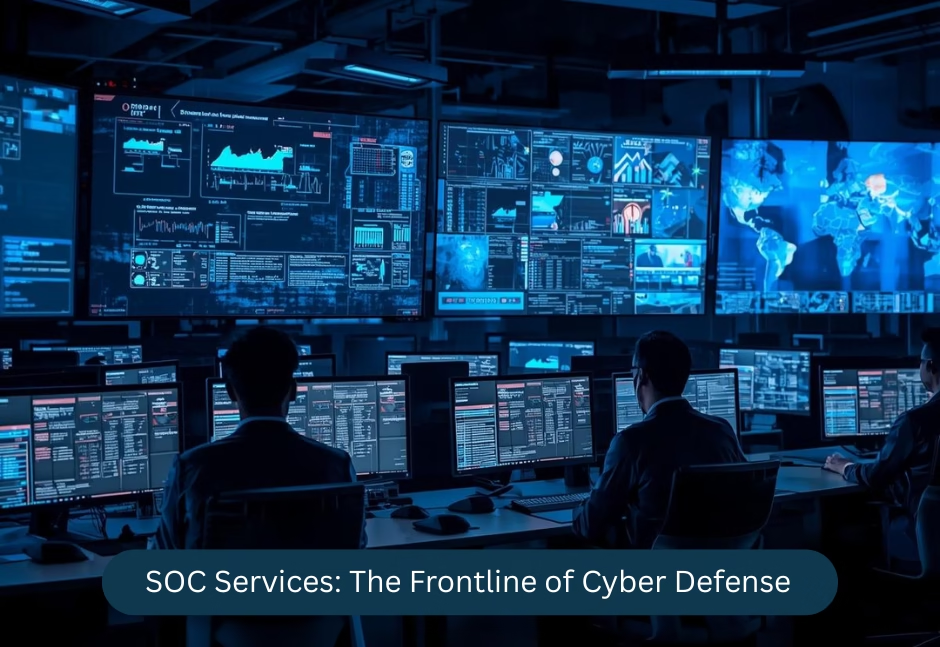Have you wondered what really stands between your business and the next cyberattack? As attackers get smarter, regular common ways of protecting your digital assets aren’t enough on their own anymore.
The Security Operations Center (SOC) is the first line of defence against digital threats. A SOC is more than just a group of people or a tool. It’s a strategic mix of intelligence, automation, and human expertise that works together to find, investigate and deal with cyber threats in real time.
In this article, we will talk about the primary tasks of a SOC and how it uses intelligence and automation for constant security. We’ll also talk about the compliance rules it has to follow to keep businesses safe and resilient.
What is a SOC Service?
A SOC service is a central function that keeps an eye on, detects, analyses, and responds to cybersecurity incidents in an organisation’s IT environment. It is the nerve centre of business security. It constantly keeps an eye on systems, networks and applications to find problems before they can turn into breaches.
A SOC is different from your regular IT security team because it works around the clock. It uses real-time data, advanced analytics, and machine learning to find and deal with threats as they happen.
What are the Key Functions of a SOC Service?

A modern Security Operations Centre performs a lot of different activities, but its main functions can be grouped into six important areas:
1. Constant Monitoring
The SOC keeps an eye on network traffic, endpoints, servers and cloud environments all the time. It does so with the help of tools like SIEM or Security Information and Event Management systems. This makes it easy to quickly check if there’s any suspicious activity or if someone is trying to break in.
2. Detecting Threats
A SOC can detect both known and unknown threats by using threat intelligence feeds, behavioural analytics and correlation rules. This includes finding possible stolen credentials, unauthorised access and advanced persistent threats (APTs).
3. Responding to Incidents
When an incident is found, the SOC is in charge of stopping it, erasing it, and bringing things back to normal. Incident response playbooks and automation tools help to speed up response time, which reduces damage and downtime.
4. Managing Vulnerabilities
SOCs actively look for weaknesses in systems. They work with IT teams to set priorities based on how bad the problem is and how easy it is to exploit.
5. Threat Hunting
Apart from automation, human analysts actively look for hidden or new threats that automated systems might miss sometimes.
6. Reporting & Compliance
The SOC makes detailed reports on incidents, trends, and how well the system is working. These reports help executives understand the organisation’s security and meet compliance requirements.
The Power of Intelligence & Automation in SOC Services
Intelligence-driven operations and automated response systems work well together in modern SOCs. Together, they can change cybersecurity from a reactive defence to a proactive one.
1. Threat Intelligence Integration
Threat intelligence learns about attackers’ tactics, techniques, and procedures (TTPs). In this way, it helps the SOC service teams stay one step ahead of them. SOC teams can quickly find indicators of compromise (IoCs) and guess how attacks will happen in the future by combining global data.
This intelligence-driven approach gives organisations the power to shift from ‘reacting’ to ‘predicting’ threats.
2. Automation for Speed & Efficiency
Nowadays, just manual monitoring is not enough. Automating SOC services, using Security Orchestration, Automation, and Response (SOAR) platforms, lets you handle repetitive tasks quickly.
Some benefits of automation are:
- Lower mean time to detect (MTTD) and respond (MTTR).
- Fewer false positives thanks to smart alert prioritisation
- Response actions that are consistent and documented
When automation and human expertise work together, organisations can get fast, accurate, and constant security, which is important in situations where every second counts.
Is SOC Compliance Necessary? What Standards Should the Service Align With?
The short answer is yes. SOC compliance is important for keeping trust, accountability, and following the regulations. A SOC must follow industry standards that define the best ways to protect data, monitor security and respond to incidents.
Some important standards and frameworks for compliance are:
- ISO/IEC 27001: This standard is about setting up and keeping an Information Security Management System (ISMS).
- SOC 2 Type II: It makes sure that service providers handle data safely to protect their clients’ interests.
- GDPR (General Data Protection Regulation): It requires strict rules for handling personal data and reporting breaches.
- NIST Cybersecurity Framework: It provides rules for finding, protecting, detecting, responding to and recovering from cyber incidents.
- PCI DSS, or the Payment Card Industry Data Security Standard: It’s very important for businesses that deal with cardholder data.
Following these standards for SOC not only makes operations more secure, but it also shows customers and partners that you are doing your due diligence. Also, compliance makes sure that there are structured ways to handle incidents, be ready for audits and protect data privacy.
Benefits of a Modern SOC Service
A well-organised SOC service gives you major strategic and operational benefits:
- 24/7 Protection: 24/7 surveillance makes sure that no threat goes unnoticed, even outside the business hours.
- Improved Visibility: Centralised monitoring gives you a complete picture of the organisation’s security.
- Fast Incident Response: Automation reduces the time it takes to find and fix problems.
- Cost Efficiency: When you outsource or automate SOC functions, you don’t need as many costly tools and big teams in-house.
- Data-Driven Decision Making: SOC-generated analytics give you useful information that you can use to make your security strategy better.
- Regulatory Confidence: Compliance alignment makes sure that your company is prepared for audits and keeps stakeholders’ trust.
Conclusion
Organisations need to go beyond surface defence and use intelligence-driven, automated protection in a time when cyber threats are both constant and complex.
A strong SOC service is the first line of defence against digital threats. It uses people, advanced analytics and automation to provide constant monitoring and quick response.
For businesses that want to protect their assets and keep their operations running smoothly, it’s advisable to check out SOC services from a reputed cybersecurity firm like CyberNX. It’s no longer optional to invest in a mature Security Operations Center. It’s a strategic need.






